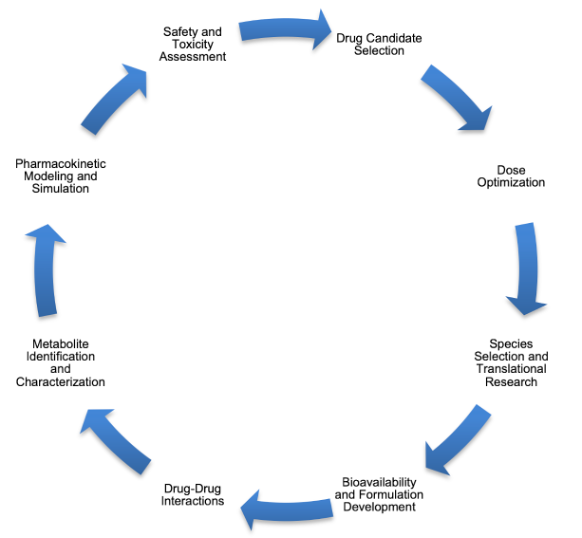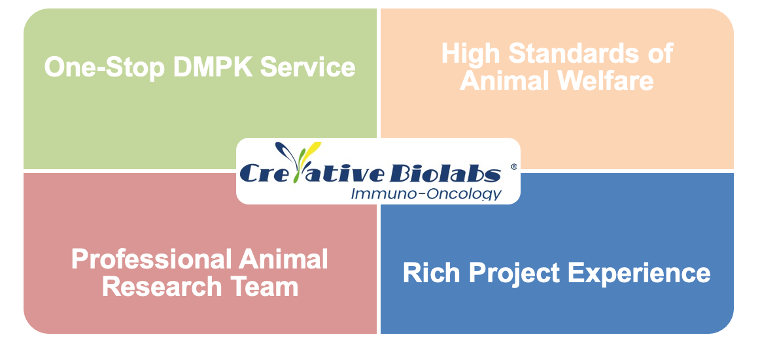Rodent In Vivo PK Service
Why Do Rodent In Vivo PK
Rodent in vivo pharmacokinetics (PK) refers to the study of how a drug behaves within the body of rodent species, such as mice or rats, over some time after administration. PK study is important in drug development to understand the absorption, distribution, metabolism, and excretion (ADME) of a drug in living organisms. This study provides valuable insights into the pharmacokinetic behavior of drugs in living organisms, helping to optimize dosing regimens, predict human pharmacokinetics, and assess drug safety and efficacy in preclinical settings.
Our Service
Creative Biolabs provides the expertise, facilities, and resources for preclinical pharmacokinetic studies in rodents for drug development and research purposes. Following is a detailed description of the content of PK services in rodents:
Animal Model
-
Creative Biolabs selects the appropriate rodent species (e.g., mouse, rat) for you based on factors such as the pharmacokinetic profile of the drug, the availability of transgenic strains, and its translatability to humans.
Dosing Strategy
-
Creative Biolabs determines the appropriate dose level and route of administration based on the characteristics of the drug and the objectives of the study.
Sample Collection
-
Creative Biolabs plans the timing and frequency of blood or tissue sample collection to adequately capture the absorption, distribution, metabolism, and elimination phases of the drug. Tail vein, retroorbital, or cardiac puncture methods can be used for blood sampling.
Blood Collection
-
Creative Biolabs uses appropriate techniques to collect blood samples, such as microsampling methods, to minimize the volume required. Timely processing of blood samples to isolate plasma or serum and store them under suitable conditions to maintain drug stability.
Analytical Method
-
Creative Biolabs offers analytical methods such as LC-MS/MS, HPLC, etc., to quantify drug concentrations in biological samples with high sensitivity, specificity, and accuracy.
Data Analysis & Reporting
-
§Creative Biolabs helps you analyze PK data to identify key parameters, including maximum concentration (Cmax), time to reach Cmax (Tmax), area under the curve (AUC), elimination half-life (t1/2), clearance (CL), and volume of distribution (Vd). In addition, Creative Biolabs documents all aspects of the study, including methods, results, and conclusions.
In addition to the in vivo PK study process described above, Creative Biolabs interprets PK parameters based on your research objectives and pharmacological properties throughout the project, implements quality control measures throughout the study to ensure data reliability and reproducibility, and conducts the study in accordance with ethical guidelines and regulations governing the use of animals in the study.
Applications of Rodent In Vivo PK
Rodent in vivo pharmacokinetics (PK) has numerous applications across various stages of drug discovery, development, and preclinical research. Here are some key applications:
 Fig.1 Applications of rodent in vivo PK.
Fig.1 Applications of rodent in vivo PK.
Why Choose Creative Biolabs
 Fig.2 Our advantages.
Fig.2 Our advantages.
Frequently Asked Question
Q1: What is the difference between the rodent in vivo PK and small animal in vivo PK?
A1: Rodent In Vivo PK: Often used in biomedical research and drug development, where rodents are commonly employed as model organisms due to their small size, ease of handling, and genetic tractability.
Small Animal In Vivo PK: This can be applied in various research contexts, including biomedical research, pharmacology, toxicology, and environmental science, depending on the specific small animal species used and the research objectives.
Q2: What are the species of rodent pharmacokinetics?
A2: For rodent pharmacokinetic studies, particularly in preclinical research, the two most commonly used species are mice (Mus musculus) and rats (Rattus norvegicus). The choice between them often depends on factors such as the specific objectives of the study, the properties of the drug being tested, and practical considerations such as availability and cost. Additionally, other small rodent species like hamsters or gerbils may be used in specific research contexts, although they are less common compared to mice and rats.
Click here to learn about non-rodent in vivo PK service!
For Research Use Only | Not For Clinical Use


 Fig.1 Applications of rodent in vivo PK.
Fig.1 Applications of rodent in vivo PK.
 Fig.2 Our advantages.
Fig.2 Our advantages.
 Download our brochure
Download our brochure